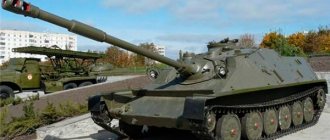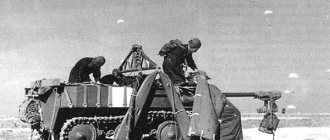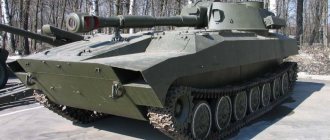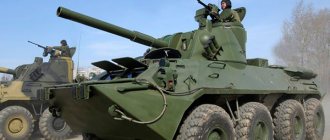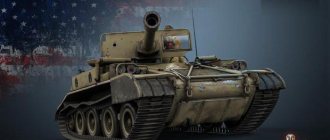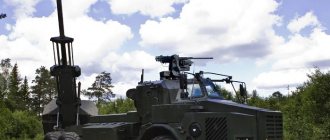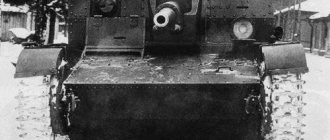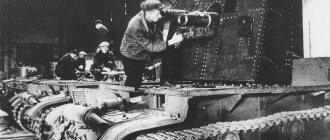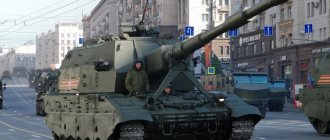We need a “fast” howitzer!
In general, I should note that each panzer division was supported by a motorized howitzer regiment, which included 24 105 mm caliber barrels, towed by powerful tractors. Since the fighting in Poland did not have the nature of a “race against time,” this artillery was quite effective; the French campaign, when the Panzerwaffe carried out a throw of hundreds of kilometers, was a different matter.
Self-propelled gun Wespe aka OSA
Of course, at the same time, the towed artillery fell hopelessly behind the units of the first line ramming the enemy’s defenses, which caused large losses and raised the question of creating self-propelled howitzer artillery, but the quick defeat of France meant that it was then “released on the brakes.”
However, the Eastern Campaign soon began, again revising the topic of self-propelled howitzers. This was due to the fact that the Germans here were faced with superior howitzer artillery of the Red Army, which mainly used five-inch caliber barrels, which were superior to the German four-inch ones in a number of characteristics, thus the maneuverability of artillery installations became an important quality.
Well, in addition, as in France, the rapid offensive of 1941 again caused the towed artillery to lag behind the advanced units.
Vespe model
At first, the Panzerwaffe command tried to solve the problem “on the knee” using captured equipment to create the required machines in an almost artisanal way. The most striking example is the Geschutzwagen I self-propelled gun, created on the basis of a light tank, but the need to have self-propelled howitzers in large quantities led to the emergence of the Vespe project in 1942, for the needs of which it was decided to use obsolete Pz tanks. II.
Excerpt describing Wespe
[“My lord brother! Yesterday it dawned on me that, despite the straightforwardness with which I observed my obligations towards Your Imperial Majesty, your troops crossed the Russian borders, and only now have I received a note from St. Petersburg, with which Count Lauriston informs me regarding this invasion, that Your Majesty considers yourself to be on hostile terms with me from the time Prince Kurakin demanded his passports. The reasons on which the Duke of Bassano based his refusal to issue these passports could never have led me to suppose that the act of my ambassador served as a reason for the attack. And in fact, he did not have a command from me to do this, as he himself announced; and as soon as I learned about this, I immediately expressed my displeasure to Prince Kurakin, ordering him to carry out the duties entrusted to him as before. If Your Majesty is not inclined to shed the blood of our subjects because of such a misunderstanding and if you agree to withdraw your troops from Russian possessions, then I will ignore everything that happened, and an agreement between us will be possible. Otherwise, I will be forced to repel an attack that was not provoked by anything on my part. Your Majesty, you still have the opportunity to save humanity from the scourge of a new war. (signed) Alexander.” ] On June 13, at two o'clock in the morning, the sovereign, calling Balashev to him and reading him his letter to Napoleon, ordered him to take this letter and personally hand it over to the French emperor. Sending Balashev away, the sovereign again repeated to him the words that he would not make peace until at least one armed enemy remained on Russian soil, and ordered that these words be conveyed to Napoleon without fail. The Emperor did not write these words in the letter, because he felt with his tact that these words were inconvenient to convey at the moment when the last attempt at reconciliation was being made; but he certainly ordered Balashev to hand them over to Napoleon personally. Having left on the night of June 13th to 14th, Balashev, accompanied by a trumpeter and two Cossacks, arrived at dawn in the village of Rykonty, at the French outposts on this side of the Neman. He was stopped by French cavalry sentries. A French hussar non-commissioned officer, in a crimson uniform and a shaggy hat, shouted at Balashev as he approached, ordering him to stop. Balashev did not stop immediately, but continued to walk along the road. The non-commissioned officer, frowning and muttering some kind of curse, advanced with the chest of his horse towards Balashev, took up his saber and rudely shouted at the Russian general, asking him: is he deaf, that he does not hear what is being said to him. Balashev identified himself. The non-commissioned officer sent the soldier to the officer. Not paying attention to Balashev, the non-commissioned officer began to talk with his comrades about his regimental business and did not look at the Russian general. It was unusually strange for Balashev, after being close to the highest power and might, after a conversation three hours ago with the sovereign and generally accustomed to honors from his service, to see here, on Russian soil, this hostile and, most importantly, disrespectful attitude towards himself with brute force. The sun was just beginning to rise from behind the clouds; the air was fresh and dewy. On the way, the herd was driven out of the village. In the fields, one by one, like bubbles in water, the larks burst into life with a hooting sound. Balashev looked around him, waiting for the arrival of an officer from the village. The Russian Cossacks, the trumpeter, and the French hussars silently looked at each other from time to time. A French hussar colonel, apparently just out of bed, rode out of the village on a beautiful, well-fed gray horse, accompanied by two hussars. The officer, the soldiers and their horses wore an air of contentment and panache. This was the first time of the campaign, when the troops were still in good order, almost equal to the inspection, peaceful activity, only with a touch of smart belligerence in clothing and with a moral connotation of that fun and enterprise that always accompany the beginning of campaigns. The French colonel had difficulty holding back a yawn, but was polite and, apparently, understood the full significance of Balashev. He led him past his soldiers by the chain and said that his desire to be presented to the emperor would probably be fulfilled immediately, since the imperial apartment, as far as he knew, was not far away.
Development of Vespe
The prototype was made by specialists - it involved a fairly serious rearrangement of the “deuce”. The engine, a 140-horsepower HL 62 TR, which accelerated the vehicle to 40 km/h, was moved to the central part in order to free up space in the stern for installing a conning tower. I note that when two tanks were fully refueled with a total volume of up to 170 liters, it provided a range of 200 kilometers on the highway.
The chassis lost one support roller, the place of the mechanical drive, due to the need to place transmission elements, had to be moved forward - for this, a small superstructure was created in the inclined frontal armor. I should also note that on later production vehicles the hull was lengthened by 220 millimeters, which increased the weight of this version of the self-propelled gun to 11.5 tons.
Wespe cabin
In the said lightly armored cabin, which had a folding rear plate, which facilitated the loading of ammunition (32 separate shots), a 105-mm howitzer IFH 18/2 L/28 was installed, which had vertical guidance angles from -5° to +42° and horizontal ±17 °. In addition to the gun, the self-propelled gun was equipped with an MG-17 machine gun; The radio equipment was represented by the Fu-5 receiving and transmitting radio station.
Unfortunately, often armor aesthetes do not pay attention to the auxiliary vehicles that ensure its operation - in order to “correct” this “injustice” I would like to draw your attention to the fact that in order to service self-propelled guns based on Pz. II, an ammunition loader was also created for it, which differed only in the absence of a barrel - the “Mun Schel” could transport up to 90 rounds.
Tactical and technical characteristics of the Vespe howitzer
— Layout diagram: engine, transmission and control compartments at the front, combat in the wheelhouse at the rear - Years of development: 1942 - Years of production: 1943-1944 - Years of operation: 1943-1945 - Number of produced, pcs.: 676
— Crew, people: 5
Vespe self-propelled gun weight
— Combat weight, t: 11.0
Overall dimensions of Vespe self-propelled guns
— Body length, mm: 4810 — Width, mm: 2280 — Height, mm: 2300 — Ground clearance, mm: 340
Vespe self-propelled gun reservation
— Armor type: rolled steel, surface hardened — Hull forehead, mm/deg.: 30 — Hull side, mm/deg.: 14.5 — Hull rear, mm/deg.: 14.5 — Bottom, mm: 6— 10 — Hull roof, mm: 10 — Cabin front, mm/deg.: 10 — Cabin side, mm/deg.: 10 — Cabin stern, mm/deg.: 10 — Cabin roof, mm/deg.: open
Armament of self-propelled gun Vespe
— Caliber and brand of gun: 105-mm leFH 18/2 — Gun type: howitzer — VN angles, degrees: −5…+42° — GN angles, degrees: ±20° — Firing range, km: 10.65 — Machine guns: 1 × 7.92 mm MG-34
Vespe self-propelled gun engine
— Engine type: in-line 6-cylinder carburetor liquid cooling — Engine power, l. p.: 140
Vespe self-propelled gun speed
— Highway speed, km/h: 40
— Cruising range on the highway, km: 140 — Cruising range over rough terrain, km: 95 — Specific power, l. s./t: 12.7 — Suspension type: individual, with leaf springs — Specific ground pressure, kg/cm²: 0.76
— Overcome ascent, degrees: 30° — Overcome wall, m: 0.42 — Overcome ditch, m: 1.7 — Overcome ford, m: 0.8
Manufactured by Wespe
Of course, the production of self-propelled guns and transporters was established at factories that had hitherto specialized in assembling Pz tanks. II, ergo, who were well acquainted with the base of these machines - these were the production facilities of FAMO and the Polish Ursus. A total of 517 and 104 vehicles were produced in 1943, respectively, and total production before termination in mid-1944 was 676 and 159 units.
Combat use
These vehicles received their baptism of fire as part of Manstein’s corps, which, after the failure of the attempt to relieve Stalingrad, held back the Soviet offensive and was even able to recapture Kharkov by March 1943. Subsequently, they fought on both the Eastern and Western fronts, as well as in the Apennines - their military career ended only with WWII in Europe.
As a rule, one Os battery included 6 self-propelled guns and a pair of transporters, which provided it with a triple ammo capacity. They operated from closed positions, although I must note that their ammo ammunition, just in case, which, as you know, can be different - especially in war, also included armor-piercing shells. The measure was by no means superfluous - breakthroughs of Soviet tanks into the depths of the Wehrmacht’s defenses often forced the use of these “blanks”.
Unfortunately, I do not have information about the details of their participation in the battles - the Germans, who treated self-propelled artillery as a secondary force, did not pay much attention to it. However, I should note that in 1943, the number of self-propelled batteries in tank divisions grew continuously, from six in May to thirty-one in December, which indirectly indicates the high efficiency of self-propelled guns.
Self-propelled gun Vespe 105 mm. Armament. Dimensions. Reservation. Weight
At the beginning of 1942, the PzKpfw III/IV chassis was considered by specialists from the logistics department as a completely suitable basis for creating self-propelled guns with 105 mm guns. However, when it became clear that these guns could be mounted on the PzKpfw II chassis without loss of quality of the final product, the PzKpfw II production lines were transferred to the production of the leFH 18/2 auf Fahrgestell Panzerkampfwagen II, better known as the Vespe (wasp).
In February 1943, production workers received an order for 1000 units of this type of product, which was considered as a temporary measure before the advent of more powerful self-propelled guns. However, the order was later cut to 835 units. The armored cabin of the Vespa housed an ammunition rack with a capacity of 32 artillery rounds, but 159 vehicles were produced as specialized ammunition transporters capable of carrying 90 shells of the appropriate caliber. Compared to the PzKpfw II, the Vespe became a little longer, the power plant moved forward, and the chassis now had not four, but three support rollers. The driver sat in a closed compartment located in the front of the hull, while the rest of the crew were placed in the open fighting compartment, protected by thin armor plates that protected them from bullets and shrapnel, but were unable to protect people from shells. The lack of a roof made the gun crew vulnerable to mortar mines and hand grenades, but for self-defense the crew had at their disposal a machine gun, which was equipped with all Vespes.
German self-propelled howitzer "Wespe" from the 116th Panzer Division of the Wehrmacht, knocked out on August 12, 1944 near the French city of Mortreux by tanks of the 5th Armored Division of the US Army. The self-propelled gun was moving in reverse when it was hit (obviously there was a threat). This is evidenced by the mark from the right caterpillar and the left caterpillar, which is in front of the self-propelled gun. Most likely, the shell broke the track, tore out the drive wheel and damaged the first road wheel, and the self-propelled gun rolled back into the recess by inertia. Before this, the crew fired at the maximum range - the elevation angle of the gun was close to the maximum (according to the technical characteristics, 42 degrees).
The main armament was intended for direct fire, but since it had a maximum elevation angle of 42 degrees, it was often used for overhead fire from remote positions. The idea of creating ammunition transporters turned out to be very productive, since it made it possible in the field to remove gun barrels from damaged self-propelled guns and place them on a gunless transporter, thus creating a new self-propelled gun. Like many other types of German armored vehicles, the Vespe managed to take part in the battle on the Kursk Bulge in the summer of 1943, after which it was constantly used on the Eastern Front. Due to its maneuverability, speed and reliability, the Vespe, unlike most heavier self-propelled guns, was popular and was used on all European fronts, including the Italian one.
The German 105-mm self-propelled gun "Wespe" (Sd.Kfz.124 Wespe) from the 74th self-propelled artillery regiment of the 2nd tank division of the Wehrmacht, passes next to an abandoned Soviet 76-mm ZIS-3 gun in the area of the city of Orel. German offensive Operation Citadel. With what intent did they throw poles on the armor? It seems a little thin to put under the tracks. Probably improvised racks for a canopy/tent, so that you don’t have to spend the night in an iron box, light a fire, and when shooting from prepared positions, make a platform out of them so that the ammunition doesn’t lie on the damp ground. but you never know for what purpose - for a soldier, both ours and a German one, any piece of wood on the farm will be useful.
"Wasp" - "Armor" ratings
Since self-propelled howitzers were actively used by all participants in WWII, I must state that the Vespe did not become something original. At the same time, it was superior to its British counterparts in a number of characteristics, somewhat inferior to the American M7 and significantly inferior to the Soviet “monsters” SU-122 and SU-152.
The obvious disadvantages of this vehicle included, first of all, those inherent to the tank on the basis of which it was created - the unreliability of the chassis and insufficient engine power.
At the same time, I should note that they were aggravated by the fact that the design of the self-propelled guns turned out to be clearly overweight, as a result, frequent breakdowns, reducing the combat readiness of units no worse than the enemy’s fire, were a common occurrence. The same factor was the reason that it only had anti-fragmentation armor, which caused clearly “extra” losses.
Sau Vespe
However, assessing the project as a whole, I can state that it was a very successful option for using an outdated tank and gun in a “secondary role.” I would also like to draw your attention to the fact that this vehicle was a universal tool for both artillery processing of the front line (to a depth of twelve kilometers) and for working on armored vehicles. Thus, the Vespa project has to be considered, if not successful, then quite effective.
Photo of self-propelled gun Vespe
German self-propelled guns and Wespe self-propelled howitzer. An overturned M4 Sherman tank can be seen in the background. Eastern front. As the tankers said, “Sherman is so tall that you can crawl under it on your knees.” This photo shows how narrow the Sherman's tracks were. This is good for unpaved surfaces, but bad for off-road conditions. In general, all non-our equipment suffered from this - both German and American-English. There is a book by D. F. Loza, “Tankman on a Foreign Car,” where all the pros and cons of this vehicle in the conditions of the Eastern Front are very well presented. The picture shows a pressure gauge installed on the barrel knurl. They will increase the air pressure in the knurl to normal, probably from the engine compressor or a high-pressure cylinder, and now they have given the barrel an elevation angle to create a hydraulic lock. The knurling of guns is usually hydro-pneumatic. The recoil brake is hydraulic. And our ZiS-3 has the same problem, and in the battery spare parts and accessories (spare tools and accessories) there is a special combined hydro-pneumatic hand pump for pumping air into the knurled wheel, and, if necessary, fluid into the recoil brake. The pump creaks on the gun frame. Two fighters take the handle of this pump (it’s 1.5 meters long) and pump it until you’re blue in the face until the required pressure is reached.
Installation of a 105-mm cannon in a light German self-propelled artillery mount "Vespe" (Sd.Kfz.124 Wespe) using a tractor-crane Sd.Kfz.9/1
German 105-mm Vespe self-propelled guns (Sd.Kfz.124 Wespe) knocked out and abandoned west of Zhitomir. The nearby self-propelled gun bore a proper name - “Annelisa”. 1st Ukrainian Front. There is no snow under the cars. Obviously, the equipment was covered with the first snow. If the duration of action is late autumn-early winter, then judging by the clean chassis, self-propelled guns have been stationed here for a long time. On the near vehicle, the caterpillar had time to “go away”, on the far one, the support and suspension rollers, the right final drive.
German 105 mm light self-propelled field howitzer Sd.Kfz. 124 "Wespe" (IeFH 18 auf Fahrgestell des GeschutzWagen II Wespe) in a firing position.
Similar
SAU 2S7 Pion (2S7M Malka) performance characteristics.
Caliber. Dimensions. Firing range of MLRS BM-21 Grad. Damage area. Rockets. Caliber. Story
120-mm mortar 2B11 complex 2S12 Sani TTX. Firing range. Weight
Mortar 2B9M Vasilek 82 mm Rate of fire. Firing range. Weight
Self-propelled gun 2S3 Akatsiya 152 mm. Firing range. Dimensions. Weight. Engine
SAU 2S1 Gvozdika 122 mm Firing range. Dimensions. Device. Weight
Gun 2A36 Giatsint-B 152 mm. Firing range. Dimensions. Device
MLRS 9K58 Smerch Damage area. Rockets. Caliber. Story
MT-12 Rapier gun. Firing range. Story. Dimensions
Howitzer D-30 122-mm performance characteristics. Firing range. Dimensions. Weight
2S4 Tulip self-propelled mortar 240 mm performance characteristics. Dimensions. Firing range. Weight
Self-propelled gun 2S35 Koalitsiya-SV 152-mm performance characteristics. Firing range. Dimensions. Weight
Howitzer Msta-B (2A65) 152 mm. Firing range. Dimensions. Weight. Ammunition
Self-propelled gun 2S9 Nona-S 120 mm performance characteristics. Firing range. Dimensions. Weight. Armament
AT-T heavy artillery tractor. TTX. Dimensions. Engine. Story
SAU 2S19 Msta-S 152 mm Dimensions. Speed. Engine. Story
MLRS 9K57 Hurricane Damage area. Rockets. Caliber. Story
TOS-1 Buratino (TOS-1A Solntsepek) performance characteristics. Damage area
Divisional gun ZIS-3 76 mm. TTX. Firing range. Dimensions. Weight
Howitzer gun D-20 152 mm performance characteristics. Firing range. Dimensions. Weight
Howitzer M-30 model 1938 122-mm performance characteristics. Firing range. Dimensions. Weight
Self-propelled gun 2S5 Giatsint-S 152 mm performance characteristics. Firing range. Armament. Dimensions. Weight
Self-propelled gun Ferdinand (Elephant) performance characteristics. Reservation. Weight. Dimensions
Self-propelled gun SU-100. TTX. Armament. Dimensions. Shells. Weight. Speed
Self-propelled gun Sturmtiger caliber 380 mm. TTX. Armament. Shells. Reservation. Dimensions
203-mm howitzer B-4 model 1931 performance characteristics. Weight. Ammunition. Dimensions
Self-propelled gun SU-152 St. John's wort 152 mm performance characteristics. Shells. Firing range. Dimensions. Weight
Gun M-46 130-mm performance characteristics. Firing range. Dimensions. Weight
Demining installation UR-77 Meteorite TTX. Armament. Dimensions
MLRS 9K51M Tornado-G. Rockets. TTX. Firing range. Dimensions
SAU 2S31 Vienna 120 mm. Firing range. Story. Dimensions. Weight
German self-propelled gun StuG III. Modifications. Dimensions. Armament. Weight
Guided projectile Krasnopol. TTX. Firing range. Dimensions. Price
Mortar Karl 600 mm and 540 mm performance characteristics. Firing range. Weight. Dimensions
Big Bertha 420 mm gun. TTX. Weight. Dimensions. Ammunition
Self-propelled gun SU-76. TTX. Dimensions. Reservation. Weight. Story
SAU 2S23 Nona-SVK 120-mm performance characteristics. Armament. Range and accuracy of fire. Dimensions
SAU 2A3 Condenser-2P caliber 406 mm Firing range. Armament. Dimensions. Weight
Mortar M-160 caliber 160-mm performance characteristics. Firing range. Ammunition. Dimensions
Airborne self-propelled gun ASU-57. Armament. TTX. Dimensions. Weight. Booking
Artillery complex A-222 Bereg 130 mm. TTX. Firing range. Ammunition
Howitzer BR-18 caliber 305 mm TTX. Firing range. Weight
152 mm howitzer D-1. Firing range. Dimensions. Weight. Device
Mortar M-240 caliber 240 mm. Firing range. Dimensions. Weight
Self-propelled gun SU-85. Ammunition. Reservation. Dimensions. Weight. Engine
Counter-battery radar Zoo-1 (1L219M). Range of control of firing positions. Device
SAU 2S25 Sprut-SD. Caliber. Story. Dimensions. Weight. Engine
Self-propelled gun 2S34 Hosta 120 mm. TTX. Dimensions. Firing range. Armament. Weight
Self-propelled gun ASU-85. Armament. Dimensions. Reservation. Weight
280-mm mortar Br-5 model 1939 Dimensions. Weight. Ammunition
Self-propelled gun 2A45M Sprut-B. TTX. Speed. Engine. Weight
Belarusian MLRS BelGrad. TTX. Firing range. Ammunition. Dimensions
S-23 cannon 180 mm caliber. Ammunition. Weight. Dimensions. Firing range
Self-propelled gun SAU SU-122. Dimensions. Armament. Reservation. Weight
Self-propelled gun Jagdpanther. Weight. Reservation. Dimensions. Armament
Multi-barreled self-propelled gun M50 Ontos. TTX. Armament. Dimensions. Booking
D-74 cannon 122 mm caliber. Firing range. Dimensions. Weight
Artillery tractor YA-12. Dimensions. Weight. Load capacity. Engine
Artillery tractor T-20 Komsomolets. Armament. Reservation. Dimensions. Weight
SAU ISU-122. Armament. Dimensions. Weight. Booking
RPU-14 (8U38) - rocket launcher
MLRS BM-24 (T) 240 mm. Firing range. Dimensions. Weight. Engine
2K32 Deva - 82-mm self-propelled mortar system
Artillery tractor Comintern. Load capacity. Dimensions. Weight. Engine
Self-propelled gun SU-122-54. Reservation. Dimensions. Weight. Firing range
MLRS BM-14-16. Armament. Dimensions. Weight. Firing range
Self-propelled gun Nashorn (Rhinoceros). Armament. Dimensions. Weight. Booking
BR-2 gun caliber 152 mm. Firing range. Dimensions. Weight
Self-propelled howitzer self-propelled gun PzH 2000. Firing range. Dimensions. Weight
BR-17 cannon 210 mm caliber. Weight. Firing range. Rate of fire
Self-propelled gun Vespe 105 mm. Armament. Dimensions. Reservation. Weight
Wheeled self-propelled gun GAZ-68 (KSP-76). Armament. Dimensions. Weight. Engine
Self-propelled gun Brummbar 150 mm. Armament. Dimensions. Weight. Booking
Heavy self-propelled gun SU-14. Reservation. Dimensions. Weight. Engine
Self-propelled gun SU-5. Armament. Reservation. Dimensions. Weight
Self-propelled gun AT-1. Reservation. Dimensions. Weight. Engine
Self-propelled gun SU-12. Armament. Reservation. Dimensions. Weight
